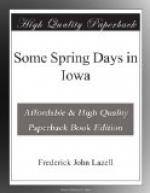* * * * *
We follow the scarlet tanager up a wide glen where wholesome smelling brake grows almost shoulder high. Suddenly there comes from our feet a sharp, painful cry, as of a human being in distress, and the ruffed grouse, commonly called pheasant, leaves her brood of tiny, ginger-yellow chicks—eight, ten, twelve—more than we can count,—little active bits of down about the size of a golf ball, scattering here, there, and everywhere to seek the shelter of bush, bracken, or dried leaves, while their mother repeats that plaintive whine, again and again, as she tries to lead us up the hillside away from them. When we look for them again they are all safely hidden; not one can be seen. The mother desperately repeats her whining cry to entice us away and we walk on up to the top of the hill and away to relieve her anxiety. Anon we hear her softly clucking as she gathers her scattered brood.
The scarlet tanager’s nest is on the horizontal limb of a big white oak. But it is not the familiar, striking, scarlet, black-winged bird, which sits on the ragged nest. The female is dressed in sober olive-green above and olive-yellow below, with dusky wings and tail. Probably many an amateur has found this bird down by the river and tried to classify her among the fly-catchers until the coming of her handsome husband caused him to remember that in birdland it is usually only the male part of the population which wears the handsome clothes, just as the Indian braves wear the gaudiest paint and the showiest feathers. It is not till we get to the higher stages of civilization that this rule is reversed.
* * * * *
The foliage of the June woods has not the delicacy of tints which was so exquisite in May, nor the strength of color which will be so striking in September. But it has a beauty no less admirable. The chlorophyll in the leaf-cells is now at its prime and the leaves very closely approach a pure green, especially those of the sycamore, which is the nearest to a pure green of any tree in the forest. Standing in the wood road which runs along the top of a timbered crest we look across a broad, wooded valley where the leaves seem to exhale a soft, yellowish green in the bright sunlight. Beyond and above them, five miles away, and yet apparently very near, a belt of bluish green marks the timber fringe of the next water course.




